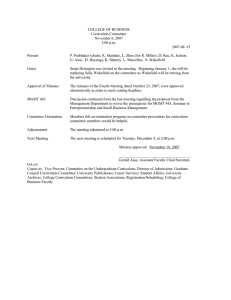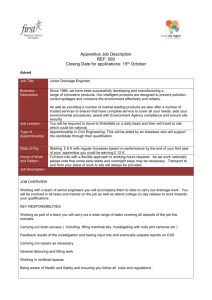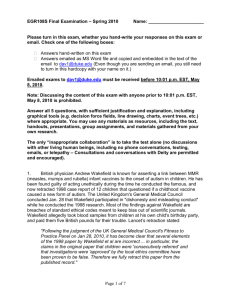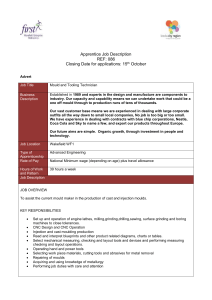Who is Dr. anDreW WaKeFieLD?
advertisement
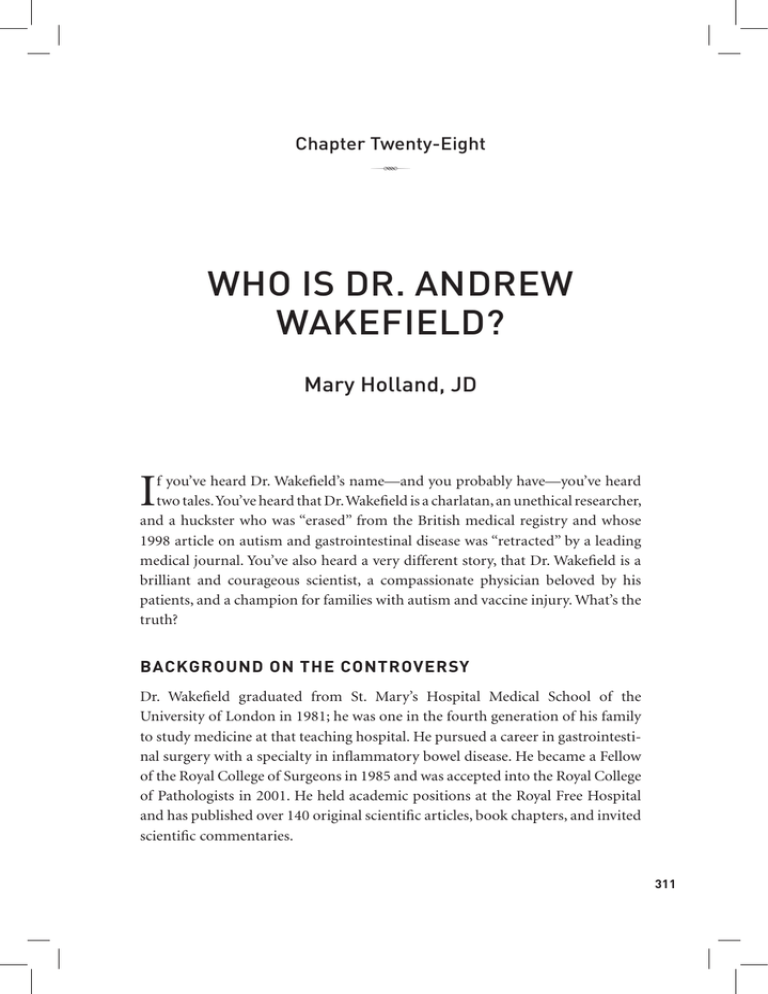
Chapter Twenty-Eight R WHO IS DR. ANDREW WAKEFIELD? Mary Holland, JD I f you’ve heard Dr. Wakefield’s name—and you probably have—you’ve heard two tales. You’ve heard that Dr. Wakefield is a charlatan, an unethical researcher, and a huckster who was “erased” from the British medical registry and whose 1998 article on autism and gastrointestinal disease was “retracted” by a leading medical journal. You’ve also heard a very different story, that Dr. Wakefield is a brilliant and courageous scientist, a compassionate physician beloved by his patients, and a champion for families with autism and vaccine injury. What’s the truth? Background on the Controversy Dr. Wakefield graduated from St. Mary’s Hospital Medical School of the University of London in 1981; he was one in the fourth generation of his family to study medicine at that teaching hospital. He pursued a career in gastrointestinal surgery with a specialty in inflammatory bowel disease. He became a Fellow of the Royal College of Surgeons in 1985 and was accepted into the Royal College of Pathologists in 2001. He held academic positions at the Royal Free Hospital and has published over 140 original scientific articles, book chapters, and invited scientific commentaries. 311 312 VACCINE EPIDEMIC TABLE 1. LANCET STUDY SIGNED CONSENT FORMSA Patient No. 01 02 03 04 05 06 07 08 09 10 11 12 a Colonoscopyb Referencec 07-21 to 07-26-96 09-01 to 09-09-96 09-08 to 09-13-96 09-29 to 10-04-96 12-01 to 12-06-96 ~11-01-96d 01-26 to 02-??-97e 01-19 to 01-25-97 11-17 to 11-22-96 02-16 to 02-19-97 NAf 01-06 to 01-10-97 Day 1, p.10 Day 1, p.08 Day 1, p.11 Day 1, p.12 Day 1, p.17 Day 1, p.14 Day 1, p.22 Day 1, p.21 Day 1, p.15 Day 1, p.23 NAf Day 1, p.19 Parental consents were obtained by August 24, 1995 (TA Reed & Co., Note 23) b Royal Free Hospital admission to discharge dates (TA Reed & Co., Note 8) c Transcript of GMC hearings (TA Reed & Co., Note 8) d “On or about” November 01, 1997 (TA Reed & Co., Note 8) e Discharge day in February 1997 was unrecorded (TA Reed & Co., Note 8) f Patient 11, a U.S. citizen, was not subject to the GMC investigations In the early 1990s, Dr. Wakefield began to study a possible link between the measles virus and bowel disease. He published a 1993 study, “Evidence of persistent measles virus infection in Crohn’s disease”1 and coauthored a 1995 article published in The Lancet, “Is measles vaccine a risk factor for inflammatory bowel disease?”2 At roughly the same time, Dr. Wakefield wrote an unpublished 250-page manuscript reviewing available scientific literature on the safety of measles vaccines.3 He was rapidly emerging as one of the world’s experts on measles vaccination. In 1996, an attorney, Solicitor Barr of the law firm Dawbarns, contacted Dr. Wakefield to ask if he would serve as an expert in a legal case on behalf of children injured by vaccines containing the measles virus. The lawyer was bringing the suit on behalf of parents who alleged that vaccines had caused their children’s disabilities, including autism. Six months before this, and independent of the litigation effort, parents of children with autism and severe gastrointestinal symptoms began contacting Dr. Wakefield because of his publications on the WHO IS DR. ANDREW WAKEFIELD? measles vaccine, asking for help for their children’s pain and suffering, which they believed was vaccine-induced. Dr. Wakefield made two major, but separate, decisions at about this time—to try to help the families dealing with autism and gastrointestinal problems, and to become an expert in the legal case regarding vaccines and autism.4 Barr asked Dr. Wakefield to study two questions: (1) whether measles could persist after measles infection or the receipt of the MMR vaccine; and (2) whether the measles virus could lead to complications, such as Crohn’s disease or autism. Due to bureaucratic delays at his hospital, however, Dr. Wakefield did not begin this litigation-related study until October 1997.5 By July 1997, Dr. Wakefield and his colleague, Professor John Walker-Smith, had already examined the “Lancet 12”—twelve patients with autism and gastrointestinal symptoms that were the basis for the case study in the 1998 article published in The Lancet. Dr. Wakefield and others had recommended the referral of these patients to Prof. Walker-Smith, an eminent physician described by his peers as one of the world’s leading pediatric gastroenterologists.6 Prof. WalkerSmith had recently moved to St. Mary’s Hospital from a different institution and brought with him the same clinical privileges and ethical clearances that he enjoyed at his previous hospital. He, a colleague, Dr. Simon Murch, and a team of other physicians, did extensive clinical workups on these sick children that Prof. Walker-Smith deemed “clinically indicated,” while Dr. Wakefield coordinated a detailed research review of the tissues obtained at biopsy. The clinical tests included colonoscopies, MRI scans, and lumbar punctures to assess mitochondrial disorders. “Clinically indicated studies” did not require permissions from The Royal Free Hospital ethics committee because the tests were required for the benefit of the individual patients.7 Dr. Wakefield’s research was covered by an appropriate ethical approval. In 1998, to announce the publication of The Lancet article coauthored by Dr. Wakefield and twelve other scientists, the dean of St. Mary’s Medical School called a press conference. While this was not standard practice, the dean presumably was seeking to enhance the school’s visibility in cutting edge research. The article was labeled in the medical journal as an “early report,” stating that it “did not prove an association between measles, mumps and rubella vaccine and the syndrome described. Virological studies are underway that may help to resolve this issue.”8 At the press conference, Dr. Wakefield was asked about the safety of the MMR vaccine. In 1992, two different combination MMR vaccines had been 313 314 VACCINE EPIDEMIC withdrawn from the U.K. marketplace because they were unsafe, so MMR vaccination was already a hot topic before The Lancet article was published. Dr. Wakefield responded that, given the paucity of combination MMR vaccine safety research, and until further safety studies were done, the vaccines should be separated into their component parts. He had previously informed his colleagues that this was his view and that he would express it if asked.9 The 1998 press conference set off a media firestorm, with large numbers of parents raising uncomfortable questions about the safety of the “triple jab” and requesting single measles, mumps, and rubella vaccines. In the midst of the controversy, in August 1998, the British government took an extraordinary step. It made separate measles, mumps, and rubella vaccine components unavailable,10 thereby forcing the hand of concerned parents. At that point, measles vaccination rates among children in the United Kingdom fell significantly. Measles disease outbreaks became more prevalent, and included a handful of cases of serious complications and deaths. Some sought to blame Dr. Wakefield for irresponsibly scaring parents and triggering a public health crisis.11 The British government had a big problem on its hands—one that would soon make its way to the United States. The controversy surrounding Dr. Wakefield simmered. In February 2004, it reached a boiling point when Dr. Richard Horton, editor of The Lancet, held a news conference to declare that the 1998 article was “fatally flawed” because Dr. Wakefield had failed to disclose financial conflicts of interest with the litigation-related study he conducted. British reporter Brian Deer published the story in the Sunday Times, detailing alleged undisclosed conflicts of interest. Immediately following publication, Mr. Deer sent a detailed letter to the British General Medical Council (GMC), which regulates the practice of medicine.12 The GMC then initiated proceedings against Dr. Wakefield that culminated in Dr. Wakefield’s delicensure13 in May 2010 and the retraction of the 1998 article from The Lancet.14 The Allegations Against Dr. Wakefield The highly publicized, multi-year, multi-million dollar prosecution against Dr. Wakefield alleged that: • Dr. Wakefield was paid 55,000 British pound sterling (about US $90,000) by litigators for the study published in The Lancet, and he failed to disclose this conflict of interest; WHO IS DR. ANDREW WAKEFIELD? • • • He and his colleagues performed medically unnecessary tests on the children in the 1998 study and lacked appropriate ethical clearances; The children in the 1998 study were selected for litigation purposes (as described in the Sunday Times article) and not referred by local physicians; and He drew blood from children at his son’s birthday party for control samples in the 1998 study with callous disregard for the distress that this might cause children.15 Based on its findings, the GMC concluded that Dr. Wakefield had engaged in “serious professional misconduct,” and “dishonest,” “misleading,” and “irresponsible” behavior, warranting the sanction of his removal from the medical profession.16 Let’s examine the GMC’s charges and the evidence. Failure to Disclose Payment from Litigators Dr. Wakefield accepted 55,000 pounds to conduct a study for the class action suit regarding vaccines and autism. This was a research grant from which Dr. Wakefield personally received no compensation. Dr. Wakefield did not start this study until after the case series for the Lancet 12 had been submitted. Legal documents prove that Dr. Wakefield’s hospital knew about this study and knew about the amount of money he received, most of which went to pay the salary of a designated laboratory technician. Documents further demonstrate that Dr. Wakefield disclosed in a national newspaper over one year before publication of the 1998 article that he was working with the litigators.17 Dr. Horton, editor of The Lancet, had been informed and should have been well aware of Dr. Wakefield’s role in the vaccine-related litigation before the publication of the 1998 article.18 “Medical Necessity” and Ethical Clearances The Lancet 12 were sick. Each child was administered tests with the intent to aid that child. The hospital administration was fully aware of the tests being conducted and made no objections. Because all of the tests were “clinically indicated” and not for research purposes, no ethical clearance beyond what Prof. Walker-Smith already possessed was required. Notably, no patient, parent, or guardian has ever made accusations against Dr. Wakefield or testified against 315 316 VACCINE EPIDEMIC him for ethical violations or medically unnecessary procedures. Dr. Wakefield and his colleagues reject the GMC’s ruling that the tests for the Lancet 12 were unnecessary. The Lancet 12’s Referrals The GMC charged that the children were referred through the litigation effort and not through ordinary medical channels. This is incorrect. Parents started contacting Dr. Wakefield long before the litigation started, and independently of it. Since the litigation study was not yet started by the time The Lancet study was completed and submitted to the journal, this finding is false. Dr. Wakefield and his colleagues reject that claim; the families contacted them directly because of their medical expertise.19 Control Blood Samples from a Child’s Birthday Party Dr. Wakefield arranged for control blood samples from healthy, typically developing children to be taken at his son’s birthday party. Most of the children’s parents were medical colleagues and friends. He did this with the children’s and parents’ fully informed consent and gave the children 5 pounds each for their trouble. The procedure was undertaken by an appropriately qualified doctor using a standard technique. The children were happy to be helpful and went on to enjoy the birthday party. While this is admittedly an unconventional method of collecting control blood samples, it hardly amounts to “serious professional misconduct” or an ethical breach warranting delicensure. The GMC’s description of this incident as an example of “callous disregard” for children’s distress seems to be a gross exaggeration.20 Indeed, the U.K. High Court of Justice exonerated Professor Walker-Smith in March 2012,21 and the Lancet journal has suggested that it is considering reversing its retraction.22 The GMC failed to prove its case against Dr. Wakefield. Using Brian Deer’s reporting as evidence, the GMC appears to have purposefully conflated the Lancet 12 study and the subsequent litigation study to create the appearance of a financial conflict of interest.23 Similarly, the GMC appears to have wrongfully applied ethical research standards to tests that were “clinically indicated” for severely ill children.24 Conflating treatment and research not only grievously harmed Dr. Wakefield and his colleagues, but set a threatening precedent for the practice of medicine. The government’s medical regulators (of uncertain expertise) second-guessed Prof. Walker-Smith, the world’s preeminent authority on WHO IS DR. ANDREW WAKEFIELD? pediatric gastroenterology, on his clinical judgment about what tests were necessary.25 Which medical decisions will regulators second-guess next? The press, and specifically reporter Brian Deer, tried Dr. Wakefield in the court of public opinion while the GMC was prosecuting him in its regulatory court. Deer alleged that Dr. Wakefield had a pending patent application for a separate measles vaccine and hoped to “cash in” by urging parents to forego the MMR for separate measles vaccines. The evidence proves that Dr. Wakefield was not a patent holder for a separate measles vaccine. St. Mary’s Hospital held a patent for a therapeutic single measles vaccine using the beneficial immune properties of transfer factor, intended for people already infected with the measles virus. This measles vaccine was not a preventive product for people unexposed to the virus; in other words, there was no possible financial competition between the MMR vaccine and the single measles vaccine for which the hospital, and not Dr. Wakefield, held a patent.26 In 2009, Deer made additional allegations that Dr. Wakefield fabricated data.27 The GMC never made this charge, but the media picked it up and, notably, the U.S. Department of Justice used it frequently in the Omnibus Autism Proceeding in the U.S. Court of Federal Claims. In those proceedings to determine whether families could receive compensation for MMR-induced autism, the US Department of Justice went out of its way to depict Dr. Wakefield as a scientific fraud, although he was not directly relevant to the proceedings.28 In his 2010 book, Callous Disregard, Dr. Wakefield shows Deer’s allegations of fraud to be fabrications.29 CPR finds no evidence of Dr. Wakefield’s scientific fraud. On the contrary, many scientists and laboratories around the world have confirmed Dr. Wakefield’s findings regarding severe gastrointestinal inflammation and symptoms in a high percentage of children with autism.30 In its February 2, 2010 retraction, The Lancet did not allege fraud.31 Relying solely on the GMC proceeding, it retracted the article, asserting that the authors had not referred the patients as represented and the study team had not received the hospital’s ethics committee’s approval. The GMC’s conclusions and The Lancet’s reliance on them appear unfounded. The Meaning of the Wakefield Prosecution What, then, was this high-profile prosecution really about? If there was no scientific fraud, no undisclosed financial conflicts of interest, no ethical breaches in performing tests on sick children, and no complaints from patients or their fam- 317 318 VACCINE EPIDEMIC ilies, then what was the big deal? Did the international scandal and multi-million dollar prosecution proceed merely to chastise a doctor for drawing blood from children at a birthday party, with their consent and their parents’ consent? Of course not. Dr. Wakefield was, and remains, a dissident from medical orthodoxy. The medical establishment subjected him to a modern-day medical show trial for his dissent.32 Dr. Wakefield’s research raised fundamental doubts about the safety of vaccines and the etiology of autism. Dr. Wakefield was punished for his temerity to caution the public about vaccine risks and to urge them to use their own judgment. Dr. Wakefield was punished for upholding vaccination choice. The purpose of the proceeding, as in any show trial, was to communicate to other doctors and scientists, and to the public, the error of the perpetrator’s ways. A show trial offers a veneer of due process but, at its core, displays naked power. The apparent intent of the prosecution was to intimidate others from following Dr. Wakefield’s footsteps and to teach the lesson that anyone in the medical or scientific community who dares to publicly question the safety and efficacy of vaccines will be punished with utmost severity. The GMC appears to have decided that if the price of such a lesson was scientific ignorance about vaccine-autism links and the suffering of severely ill children, then so be it. Dr. Wakefield was made an example. The GMC destroyed Dr. Wakefield’s professional reputation and livelihood, and The Lancet and other publications confiscated his professional accomplishment through retraction. The GMC colluded with The Lancet, the media, the British Department of Health, the pharmaceutical industry, and even with the U.S. Department of Health and Human Services and the U.S. Department of Justice, to discredit Dr. Wakefield. The Center for Personal Rights is confident that the world will look back at the prosecution of Drs. Wakefield, Walker-Smith, and Murch with shame and remorse. Dr. Wakefield has joined in a long, honorable tradition of dissidents in science and human rights. The world has benefitted profoundly from other courageous dissidents in science—Galileo, who argued that the sun is the center of the universe; Semmelweis, who reasoned that doctors must wash their hands to prevent transmission of infection; Needleman, who proved that lead exposure causes neurological damage in developing children; and McBride, who demonstrated that thalidomide caused birth defects.33 As Thomas Kuhn explained, WHO IS DR. ANDREW WAKEFIELD? changing scientific paradigms is a revolutionary process, with the wrenching upheaval that revolution brings.34 In due course, the world has paid tribute to human rights dissidents, as well—Nelson Mandela moved from prison in South Africa under apartheid to become its most beloved President; Andrei Sakharov left Russia’s internal exile to become its moral beacon; Vaclav Havel left a Czech prison to become its first post-communist President; and Liu Xiabo, a Chinese human rights advocate, received the 2010 Nobel Peace Prize in absentia because he remains incarcerated. In time, China will embrace Mr. Liu and look to him to help create a better future. Before long, the world will likely recognize that it was Dr. Wakefield, not his detractors, who stood up for the practice of medicine and the pursuit of science. Dr. Wakefield remains an unbowed dissident in the face of a repressive medical and scientific establishment. To learn more about his work and why it is controversial, see chapter 7, “An Urgent Call for More Research on Science,” chapter 30, “The Suppression of Science,” and chapter 29, “The Exoneration of Professor John Walker-Smith: A Great Wrong Partly Righted.” *** Mary Holland is a research scholar at NYU School of Law. She has written and edited books and articles on human rights and law. She has clerked for a federal judge, worked at the Lawyers Committee for Human Rights, and at prominent U.S. law firms. She has testified before Congress, filed amicus briefs, and appeared on Court TV, Fox, CBS, and NBC. She graduated from Harvard College and holds graduate degrees from Columbia University. She is a cofounder and board member of the Center for Personal Rights. Reprinted with permission of Skyhorse Publishing, Inc. from Vaccine Epidemic by Louise Habakus and Mary Holloand (Skyhorse Publishing, 2011). Copyright 2011 The Center for Person Rights, Inc.” The book can be purchased on Amazon.com or Barnesandnoble.com or wherever books are sold. *** 319
